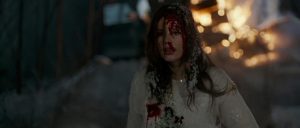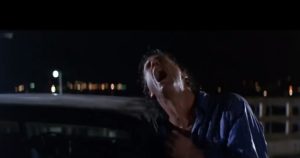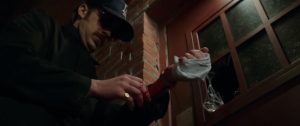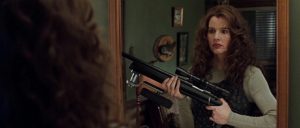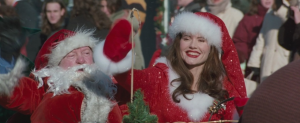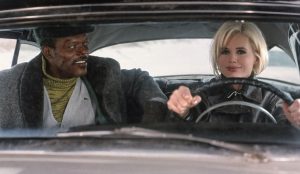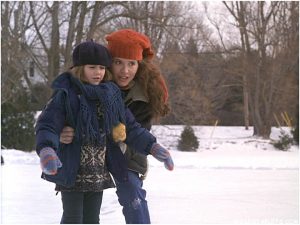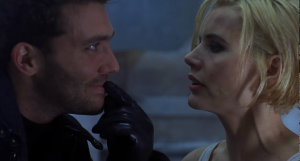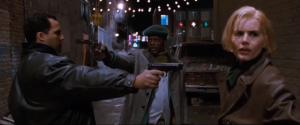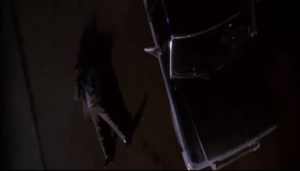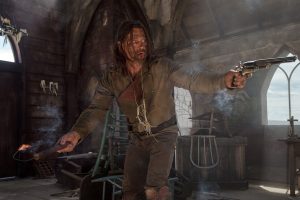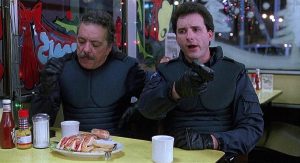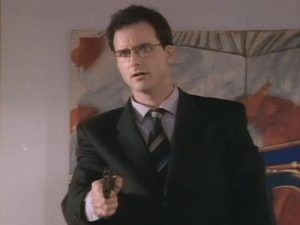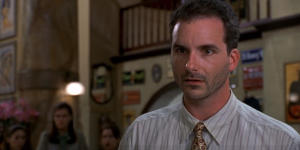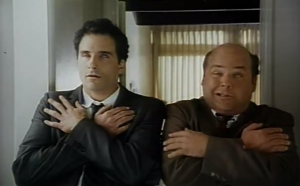OSS17-0913/1007FW102-3: – A Guide to the Films of Shane Black Part 3
“Life is pain. Get used to it!”
– Sam Caine, The Long Kiss Goodnight
Shane Black socks suffering back into action cinema. Like the gumshoes and gangsters of his beloved pulp fiction that are so often beat bloody and unconscious, Black’s heroes are hurting, and he makes damn sure the audience feels it. Emotionally, all his protagonists are processing trauma. But physically, too, their muscles and flesh are brutalised with an honesty uncommon to the genre.
Characters weather realistic relationships with physical pain. Their fortitude is sustaining but their bodies are fallible. Lethal Weapon’s Riggs periodically dislocates and later pops back his own shoulder, conveyed through a shrieking grimace from Mel Gibson, himself a filmmaker renowned for an interest in agony.
Predator’s preening, flexing musclemen “ain’t got time to bleed” as they hunt and are hunted by selva madre herself, a vagina-faced alien yardie that’ll rip out their spines or flay them alive – but “if it bleeds, we can kill it.”
In The Last Boy Scout, athlete Jimmy Dix’s body was his currency, and then he went into the red – “Starts out painkillers, Demerol, because your fucking knees are shot. Before you know it you’re chewing Codeine with your pancakes.” In Last Action Hero, Jack Slater’s sudden vulnerability turns the plot, a sobering shot through the sternum – “Here, in this world, the bad guys can win.”
Kiss Kiss Bang Bang’s Harry Lockhart loses, reattaches and reloses a finger. Similarly, In The Nice Guys, Holland March is introduced viscerally ripping open his wrist on a broken window; a few scenes later and that same arm is carefully broken by a man that will soon become his partner. In ineffectual protest, March yelps comically, “I’m dealing with an injury!” – like the Hollywood sign left to rot in the same film, it’s Black’s entire body of work in synecdoche.
Pain and its infliction is at its clearest in The Long Kiss Goodnight, Black’s final, full-throated invective before reclining disaffected into an unhappy professional silence so long that it spanned almost my entire first decade of moviegoing proper.
Goodnight is a shivering, wounded, despondent detective noir. Bundled up, shoulders hunched, caustic in communication, in enmity with the world. Its environs are overcast and palpably frigid. Characters traverse frozen waters, or find themselves immersed in them. Early on, the innocent gambol of a benign Bambi causes mayhem. Just being outdoors seems like an act of survival, and that’s before the assassins arrive.
Art reflects artist. Ten years prior, the fabled Pad O’ Guys was a 24-hour hangout zone of pizza and pop culture, a Hotel Chelsea for young men making it in movies – Black & Dekker, Matheson & Solomon, David Arnott, David Silverman, apparently even David Fincher.
Million-dollar success transplanted that mood of fraternal collegiate indulgence to a mansion in Hancock Park and by 1995 the harmless hedonism of an AV club allnighter had been amplified to an alienating distortion. The party never stopped. Black was using, boozing, disillusioned.
In that climate, for the first and only time, a writer in love with Hollywood set his story outside Los Angeles, preferring instead his home state of Pennsylvania. For the first and only time, a writer in love with the holidays found his picture postcard smalltown white Christmas but then felt compelled to subvert it, to write a Yuletide that has never felt more unsentimental, lonely and cold. “Call your fucking kid”, sneers Mitch to partner Charly, “It’s two days to Christmas. She might be under the mistaken impression mommy gives a fuck.”
Black was pained and pessimistic and primed for professional decline. He put that pain onto the page. It wasn’t catharsis and the party wasn’t over – it would be more than a decade before Shane got clean. Doesn’t matter. The Long Kiss Goodnight is his most sophisticated work. It stands as his deepest, most honest depiction of trauma, suffering and endurance. It is the anguished, snarling, resolute rebuke of a survivor.
This is Part 3 of our guide to the films of Shane Black.
The Long Kiss Goodnight (Renny Harlin, 1996)
written and produced by Shane
No Joel Silver, no Jeffrey Boam, no writing partner, no script doctors – this is 100 proof Shane, but with a greater intelligence than ever before, typified by a single bold realisation: the only reason to write this story, the only way it could make any sense, is to write it with a heroine.
His lead is magnificently realised by Geena Davis and ranks alongside Cameron’s Ripley and Sarah Connor in the pantheon of female action protagonists. Davis’ dynamic with co-star Samuel L. Jackson is a joy, and the most interesting team-up of Black’s career. The casting of the supporting players results in a triumph of quiet menace. The trademark verbal sparring has never felt more unaffected.
The mood is sombre, desperate, and at times despairing. Its themes are elaborated with a commendable new maturity. This just might be his masterpiece.
Does the title begin with an L?
Definitely, and there’s a “kiss” in there, too.
Is it set at Christmas?
Kidnap?
Word.
Blackmail?
Not this time.
Mismatched partners?
Black guy, white lady
Hyper-competent assassin-turned-schoolmarm thanks to Hollywood amnesia Charly Baltimore and fuck-up former five-oh black private dick who isn’t a sex machine with any of the chicks Mitch Hennessey. “I never did one thing right in my life, you know that? Not one. That takes skill.”
Fallen angel?
Davis plays both Madonna and whore, as milk-and-cookies wife-and-mother Sam Caine (write it down…) and her aforementioned cover/alter ego, the sardonic government spook.
Trash-talking teen?
Instead it’s a cute kid in the form of Black favourite Yvonne Zima, pleasingly un-irritating as Charly’s sproglet.
Domestic bliss?
Charly’s spent the last eight years living in the bucolic beauty of small-town Pennsylvania with a kid and then a partner. “No, it’s not a fantasy! I’m on the goddamn PTA!” Hennessey, the PI she hired to uncover her past, is yer typical Shane Black deadbeat dad – heart of gold but empty pockets and all the career prospects of a discarded sandwich.
Post-traumatic Shane disorder?
Even a screenplay credited solely to Shane couldn’t find room in its final draft for a brace of brutal backstories: an adolescent Charly blamed herself for the violent death of her abusive fuck of a father, while cop-turned-con Mitch was raped in prison, which would have certainly altered the tenor of his hilarious “ass-fucking” threat at the beginning of the film.
Remaining, though, is a psychological struggle between Charly and Samantha, particularly with regard to daughter Caitlin and the conflicted maternal emotions she evinces – “I didn’t ask for the kid, Mitch. Samantha had the kid, not me. Nobody asked me!”
Convoluted conspiracy?
Government budget cuts! As exposited by puppetmaster Perkins, “Well, unfortunately, Mr Hennessey, I’ve no idea how to fake killing 4,000 people – so we’re just going to have to do it for real. We’ll blame it on the Muslims, naturally.”
Scene-stealing henchman?
The ever-dependable David Morse cameos as a CIA torturer.
Brilliant second-baddie?
Forgotten ‘90s never-was Craig Bierko gives good psycho as phlegmatic CIA killer Timothy, whose intimacy with old flame Charly and predilection for knives creates the memorable bon mot, “Oh, honey – only four inches?” / “You’ll feel me!”
And who was actually the baddie?
Patrick Malahide’s Perkins, barely in it.
None more Black I
Headhunter: Evening lady, how about some company?
Charly: No thanks, I’m saving myself ‘til I get raped.
and moments later, in the same scene,
Headhunter: Hey honey, this is a really big fucking gun.
Mitch: This ain’t no ham-on-rye, pal.
Charly: What the Hell are you doing?
Mitch: Saving your life. I woulda been here sooner but I was thinking up that ‘ham-on-rye’ line.
None more Black II
For the sake of irritated pragmatism, Charly unexpectedly kicks Mitch out of their speeding car and onto the road. Laid out face-up on the asphalt, Mitch slowly reaches into his pockets for his lighter and cigarettes and proceeds to smoke another Newport.
Minor works
There are but two Black screenplays I’m yet to catch up with. The short film A.W.O.L., something of a myth in my cinematic adolescence, is essentially a reduction of his first work Shadow Company. Shot at the end of the century and not commercially available until several years later, the ‘Nam-set supernatural thriller features The Rock co-stars John C. McGinley and David Morse, the latter previously seen in The Long Kiss Goodnight. Black authored the piece as a donation to an American Film Institute thesis which also saw contribution from Fred Dekker.
Shane and Fred collaborated more closely on my second blindspot, Edge, a prospectively dope 2015 pilot for a bloody Western serial that nevertheless wasn’t picked up – yet.
More diverting than these works is Black’s hobby as an actor, a rather sweet side hustle serving to remind us that for most of the last 25 years Shane’s been a millionaire bachelor with a lot of time on his hands. I also dig how in half these parts he looks exactly like a personification of cocaine.
Most writers who act outside their own films fall into three camps: a supporting role borne from mutual appreciation, like Spike Jonze in The Wolf of Wall Street; a supporting role since they were once an actor anyway, like Rob Reiner in The Wolf of Wall Street; or a supporting role because they never really stopped acting, like Jon Favreau in The Wolf of Wall Street.
But Black’s acting gigs are different. His scattershot filmography, mostly cameos and walk-ons, spans the spectrum of Hollywood filmmaking from “and the nominees are” right down to “was this shot in Ed Solomon’s apartment?” Investigation becomes a rabbit hole of obscure shorts and unobtainable indies.
His work as an actor conveys a desire to understand both sides of the camera, yes; shows a heartening fun-with-friends attitude, sure; but, charmingly, also suggests that, actually, Shane Black is still trying to be an actor.
In his first flurry of fame, Shane cropped up in bit parts in brother Terry’s Dead Heat, Night of the Creeps and Robocop 3 for friend Fred Dekker, and in two episodes of Dark Justice, for which pal James Cappe was a writer and producer.
There were three films with John McTiernan – writer on Last Action Hero, extra on The Hunt for Red October and, most famously, full-blown supporting role as Predator‘s unforgettable Hawkins.
I particularly like his cameo in As Good As It Gets, reflecting several years under the tutelage of godhead James L. Brooks, in which the round of applause he receives for ejecting Jack Nicholson’s insufferable Melvin Udall rather doubles as a commendation for genuinely excellent acting work. Few writer-directors look cooler in just a shirt and a tie and a three-day stubble. (By the way, bottom left – that’s Missi Pyle!)
Recently, a role in the apparently risible Sean Bean VOD thriller Any Day, the access point for which, as far as I can tell, appears to be an association with writer-director Rustam Branaman, who worked on Dark Justice and played a bit-part in Iron Man Three. This year, Swing State, a political satire I’ll describe optimistically as Tootsie-meets-Bulworth on a budget, the provenance of which I’ll continue to pursue.
Most interesting to Luke and me are Mike the Detective and Monkeys, a couple of short films with Bill & Ted writer Chris Matheson, a professional assertion of the friendships forged 30 years ago at the Pad O’ Guys. Mike is like ‘90s Lynch adapting Chandler with the staging of Stoppard’s Rosencrantz and Guildenstern are Dead. Black proves a fine lead, it’s a fascinating project, and we’ll unpack it later this month.
“Anyone who’s ever been killed will never forget the feeling. And the thing is, I was so close.”
– Mike the Detective, Mike the Detective
Further reading: We go back to the ’80s with The Monster Squad and Lethal Weapon in Part 1 of our Spotter’s Guide to Shane Black and Lethal Weapon 2, The Last Boy Scout and Last Action Hero in Part 2.
Further listening: We discuss what’s Black, Blacker and Blackest in our tribute to Shane Black on this podcast.
